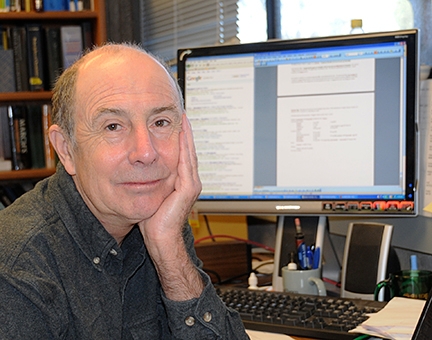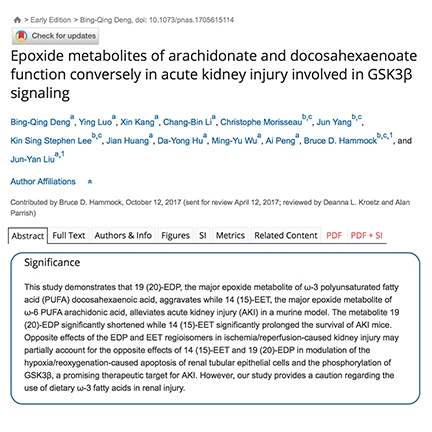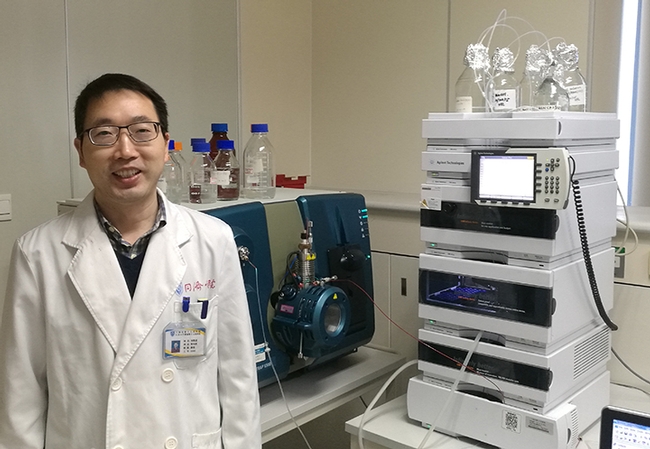
Make that a scientist who knows about soluble epoxide hydrolase, and a physician who knows about acute kidney injury (AKI), formerly called acute renal failure.
"It makes my brain hurt (reading it)," commented a colleague who is neither.
However, it's an important research paper published in the current edition of Proceedings of the National Academy of Sciences and it's co-authored by a distinguished UC Davis professor trained as an entomologist: Bruce Hammock, who holds a joint appointment with the UC Davis Department of Entomology and Nematology and the UC Davis Comprehensive Cancer Center.
The gist of it: newly published research by an international team of scientists, headed by the Jun-Yan Liu lab of Tongji University, Shanghai, China, and the Bruce Hammock lab at UC Davis, may provide promising therapeutic strategies for those suffering from acute kidney injury (AKI), formerly called acute renal failure. Access PNAS article.

“The soluble epoxide hydrolase or sEH degrades chemically stable fatty acid epoxides,” explained Hammock. “But sometimes it can be useful to block the function of sEH, so that beneficial fatty acid epoxides, like those from omega-3 and omega-6 fatty acids, are not degraded. These fatty acid epoxides have been found to protect the kidney, reduce inflammation, inflammatory pain, and even chronic or neuropathic pain.”
In general, the epoxides of docosahexaenoic acid (DHA) from fish oil make the soluble epoxide hydrolase inhibitors even more effective, the Hammock lab has found. “However, in this case, the fish oil seemed to be deleterious rather than beneficial when combined with the sEH inhibitors with kidney injury,” Hammock said. This was unexpected and the investigators caution that fish oil may not always have beneficial effects.
Professor Jun-Yan Liu, a former postgraduate researcher and assistant project scientist in the Hammock lab, related that the lipid mediators that preserve the kidney in AKI are termed EETs. “Their levels can be changed by altering their degradation or biosynthesis with selective inhibitors. This increase in EET resulted in anticipated decreases in the plasma level of creatinine and urea nitrogen—both biomarkers for kidney injury.” He added that they are looking forward to the epoxide hydrolase inhibitors finishing phase I clinical trials in humans so they can be evaluated for preventing or treating AKI.
Specifically, the researchers discovered that a 14(15)-EET mitigated kidney injury and prolonged life, while another epoxide, 19(20)-EDP from fish oil, exacerbated the kidney injury and shortened life. “We found that epoxides of docosahexaenoic acid (DHA) and DHA-enriched fish oil worsened kidney injury prophylactically and therapeutically in multiple animal models of AKI,” wrote Liu, pointing out that fish oil has proven beneficial in a number of other investigations.
Statistics show that “the incidence of AKI in hospitalized patients increased dramatically from 4.9 percent in 1983 to 20 percent in 2012,” the researchers wrote in their paper. “The mortality from AKI is greater than 50 percent; worldwide, approximately 2 million people die of AKI every year. Therefore, novel, safe and effective approaches are urgently needed to prevent and treat AKI.”
Says Weiss: “Because AKI has no specific effective therapy and treatment is merely supportive frequently requiring hemodialysis any new treatment or therapeutic paradigm would be welcome in the nephrology community and has the potential to improve the lives of many patients with AKI."
Kidney injury expert Alan Parrish of the University of Missouri's School of Medicine, Columbia, also not involved in the research, called the findings “significant.”
“The collaborative studies between Dr. Liu's and Hammock's group are an elegant, and timely, contribution to our understanding of acute kidney injury (AKI),” said Parrish, vice chair for education and director of Graduate Studies for Medical Pharmacology at the medical school. “AKI has potentially devastating short-term consequences - high mortality - as well as the detrimental long-term impact on renal function. Importantly, specific interventions to treat AKI in patients have not yet been identified. These results are significant in that they provide a unique mechanistic insight into pathways targeted by soluble epoxide hydrolase inhibitors that attenuate AKI, providing a powerful rationale for future clinical trials in AKI patients.”
Bruce Hammock knows well the tragedy of AKI and its terrible toll. "When I was in a burn unit in the U.S. Army, many patients faced their last few hours with sepsis and AKI. I have had my mom and cousin die of acute renal failure. It is not all that rare, and there is not much a doctor can do now except watch. Dialysis normally comes too late--and dialysis comes with its own problems."
The paper is the work of scientists led by Jun-Yan Liu from the Center for the Nephrology and Metabolomics and Division of Nephrology and Rheumatology, Tongji University School of Medicine, Shanghai, China: Bing-Qing Deng, Ying Luo, Xin Kang, Chang-Bin Li, Jian Huang, Da-Yong Hu, Ming-Yu Wu, and Ai Peng; and Hammock and his lab researchers Jun Yang, Christophe Morrisseau, Kin Sing Stephen Lee at UC Davis.
What's next?
"For humans, we are supported by the National Institutes of Health Blueprint Program to take this through Human Phase I," Hammock says. "We hope to be in Phase 1 next year. We are looking for support for Phase II. Once Phase 1 is finished, there should be an IND that can be referenced for physician-initiated trials. We are looking for angel or venture funding for similar FDA trials in horses and companion animals.”
“The epoxy fatty acids and sHE inhibitors block ER stress," Hammock says. "Thus, they should help with a number of disorders that arise from ER stress. We are first targeting neuropathic pain in humans and inflammatory pain in horses and companion animals.”
The intellectual property status? “Some licensed by the University of California to EicOsis LLC (a company founded by Hammock, the CEO) and others are EicOsis patents.”
Licensing? “Licensed exclusively to EicOsis, but EicOsis is interested in partnerships or sublicenses for specific indications.”
Resources:
Access PNAS article
Hammock lab: http://www.biopestlab.ucdavis.edu/Epoxide_Hydrolase/
Attached Images:
